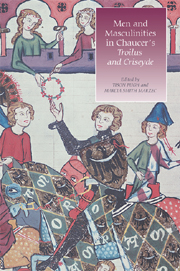Book contents
- Frontmatter
- Contents
- Contributors
- Abbreviations
- Introduction: The Myths of Masculinity in Chaucer's Troilus and Criseyde
- 1 “Beautiful as Troilus”: Richard II, Chaucer's Troilus, and Figures of (Un)Masculinity
- 2 The State of Exception and Sovereign Masculinity in Troilus and Criseyde
- 3 Revisiting Troilus's Faint
- 4 What Makes a Man? Troilus, Hector, and the Masculinities of Courtly love
- 5 Masculinity and Its Hydraulic Semiotics in Chaucer's Troilus and Criseyde
- 6 Masochism, Masculinity, and the Pleasures of Troilus
- 7 “The Dreams in Which I'm Dying”: Sublimation and Unstable Masculinities in Troilus and Criseyde
- 8 “A Mannes Game”: Criseyde's Masculinity in Troilus and Criseyde
- 9 Troilus's Gaze and the Collapse of Masculinity in Romance
- 10 Sutured Looks and Homoeroticism: Reading Troilus and Pandarus Cinematically
- 11 Being a Man in Piers Plowman and Troilus and Criseyde
- 12 “The Monstruosity in Love”: Sexual Division in Chaucer and Shakespeare
- Index
- CHAUCER STUDIES
Introduction: The Myths of Masculinity in Chaucer's Troilus and Criseyde
Published online by Cambridge University Press: 12 September 2012
- Frontmatter
- Contents
- Contributors
- Abbreviations
- Introduction: The Myths of Masculinity in Chaucer's Troilus and Criseyde
- 1 “Beautiful as Troilus”: Richard II, Chaucer's Troilus, and Figures of (Un)Masculinity
- 2 The State of Exception and Sovereign Masculinity in Troilus and Criseyde
- 3 Revisiting Troilus's Faint
- 4 What Makes a Man? Troilus, Hector, and the Masculinities of Courtly love
- 5 Masculinity and Its Hydraulic Semiotics in Chaucer's Troilus and Criseyde
- 6 Masochism, Masculinity, and the Pleasures of Troilus
- 7 “The Dreams in Which I'm Dying”: Sublimation and Unstable Masculinities in Troilus and Criseyde
- 8 “A Mannes Game”: Criseyde's Masculinity in Troilus and Criseyde
- 9 Troilus's Gaze and the Collapse of Masculinity in Romance
- 10 Sutured Looks and Homoeroticism: Reading Troilus and Pandarus Cinematically
- 11 Being a Man in Piers Plowman and Troilus and Criseyde
- 12 “The Monstruosity in Love”: Sexual Division in Chaucer and Shakespeare
- Index
- CHAUCER STUDIES
Summary
What is a man? What groups together approximately half of the humans on this planet, in contrast to the other half? Jacqueline Murray states it bluntly, noting that the male genitals are “inextricably linked to a man's sense of self and his masculine identity.” Although this formulation may appear somewhat stark, it is not to be left aside, for the physical form upon which masculinity is enacted and thus reproduced must be taken into account in analyzing the intersections between masculinities (the cultural constructions of gender in relation to male bodies) and men. Beyond the physical presence of genitals on male bodies, men are also expected to perform sexually in the enactment of masculinity. Confronting these bald facts helps us to achieve the goals of masculinity studies, one of which is, as Murray states, to “reinsert men into the picture, men qua men, men in their historical and cultural specificity.” Thus, we see that penises – those floppy appendages, subject to irrepressibly awkward and sometimes invited tumescence – matter; they make men, and although we need not dip too deeply into psychoanalysis in this brief introduction, they also highlight fundamental biological differences between men and women that influence other factors of personal identity. In offering this volume of essays, Men and Masculinities in Chaucer's Troilus and Criseyde, we hope to continue the ongoing process of understanding the ways in which gender and sexuality underpin (and at times undermine) human relationships.
- Type
- Chapter
- Information
- Publisher: Boydell & BrewerPrint publication year: 2008

